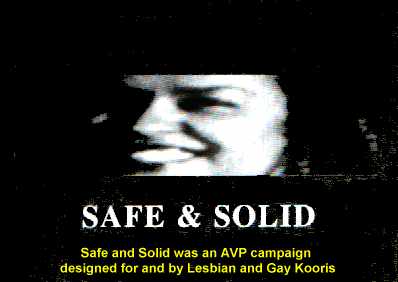

| "There appears
to have been a much less violent focus on or taboo [against homosexuality]
in Indigenous societies. There is no specific evidence to say that gays
or lesbians were removed from communities. There's actually more evidence
to say yes, it was much more accepted, " says Sydney University lecturer
and out Koori lesbian, Wendy Brady.
Brady has been involved with the NSW Lesbian and Gay Anti-Violence Project (AVP) materials to get the anti-homophobia message out to the state's Aboriginal and Torres Strait lslander (ATSI) communities. "This year there's a number of us who've been acting as an advisory group to the AVP, and we're just in the early stages of getting together the material to focus on Aboriginal youth," she says. "I think the main focus of it is that we are all family and we need to respect each other and we expect other people to respect the differences we have, so we have to respect the differences within our own communities." Brady says it can sometimes be difficult to ascertain whether violence directed at indigenous lesbians and gay men is primarily because of the victims' race, sexuality, or a combination of the two. "I think at times there are some experiences that Aboriginal gays and lesbians have in communities that are based on Western European attitudes, and those are introduced attitudes," she says. "[Within the communities] there appears to be a degree of acceptance [of homosexuality], if it goes unspoken. But for many of us who are lesbian or gay, the central identification we have is as Aboriginal people. our sexuality is a major theme within our identity but our primary identity is our Aboriginality. That doesn't deny that there are many of us who come out and speak openly as gays or lesbians, but the issue is that violence can centre around the fact that we are Aboriginal, and that comes from the dominant Western European culture. "I think that our sexuality is under threat at times when we are known or recognised as being gay, lesbian or transgender, and at those times the intersection between Aboriginality and sexuality can become blurred." Brady says that materials produced for indigenous peoples will go out through the state's existing ATSI networks. Mainstream advertising utilised for other AVP campaigns, such as the use of public transport with the "Homophobia: What are you scared of?" project, would in this case fail to reach the intended audience. "Buses don't have a wide enough audience. . . it's through organisations where our youth have direct connections that those sort of materials should go out," she said. "They'll be distributed through our indigenous organisations, for example the Land Council, community associations, and school and health groups. [There will also be] a particular emphasis on groups with state-wide connections, for example our education organisations. It's important to do that because local organisations have much more contact with young people than, say, non-Aboriginal groups. "We look to those organisations to support the program, because if we get that support then [the campaign is seen as being] much more within a community context - and supporting those projects is something that's seen to be acceptable." Koorivoice
- March/April 1997
|
| Other AVP initiatives:
First Australians launch an Australian first Reconcilation: Hand in Hand Homophobia: What are you scared of? |
